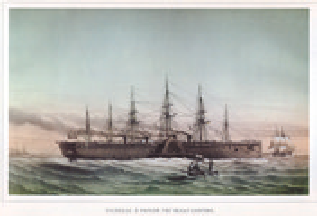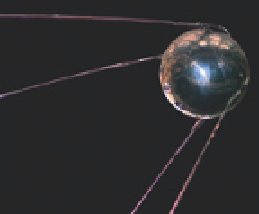Information Technology Reference
In-Depth Information
and took it to the appropriate transmitter for sending to the next relay cen-
ter, until the message reached its final destination. At the height of the tele-
graph's popularity, a major relay station had dozens of inbound receiving and
outbound transmitting terminals, with scores of operators and thousands of
messages queued up during peak hours. Our present-day computer networks
also use a store-and-forward system, not for whole messages but for standard-
size pieces of information called
packets
.
Fig. 10.6. Isambard Kingdom Brunel's
Great Eastern was the largest ship afloat
in 1865 and was ideally suited to cable
laying. On 13 July 1866, the ship left
Valentia Bay in Ireland and arrived in
Newfoundland two weeks later.
Nuclear war and packet switching
The idea of a digital communication network using
packet switching
, which
breaks up the message into small packets for transmission, occurred almost
simultaneously to two researchers on different continents - but for very dif-
ferent reasons. Paul Baran was a researcher at the RAND Corporation in Santa
Monica (
B.10.7
). The RAND Corporation - RAND is an abbreviation of Research
ANd Development - was originally part of the Douglas Aircraft Company and
was set up as an independent nonprofit research organization in 1948. Baran had
previously worked for the Eckert-Mauchly Computer Corporation on the UNIVAC
computer and for the Hughes Aircraft Company in Los Angeles on the computer-
ized Semi-Automatic Ground Environment (SAGE) early warning system. Hughes
was bidding on a contract for the control system for the Minuteman missiles, and
Baran became alarmed, because, as he said later, “You had all these missiles that
could go off by anyone's stupidity. The technology was never to be trusted.”
5
When Baran joined RAND in 1959, he set out to study the problem of
whether U.S. communication systems could survive a nuclear attack by the
Russians. The late 1950s were times of great political tension between the
United States and the Soviet Union. Two years earlier, the Soviets had managed
to put a satellite into Earth orbit, an event that the United States interpreted
as a clear threat to national security (
Fig. 10.8
). Both the United States and the
Soviet Union had large stockpiles of nuclear weapons. For these nuclear arse-
nals to work as a deterrent to war, it had to be evident to each country that the
other country would be able to launch a retaliatory attack after a first strike.
This was the doctrine of
mutual assured destruction
, usually known by the acro-
nym MAD. If the early warning systems failed and missiles had exploded on
U.S. territory, the president needed to have the “minimal essential communica-
tions” to launch a counterattack.
Until Baran's arrival at RAND, there had been little progress on how to pro-
tect the U.S. communications network in the event of a nuclear attack. Because
of his familiarity with digital computers, Baran found that he thought about the
problem very differently from most of his colleagues at RAND. He said, “Many
of the things I thought possible would tend to sound like utter nonsense, or
impractical, depending on the generosity of spirit in those brought up in an
earlier world.”
6
Signals on a telephone network were
analog
signals, in which
the amplitude of the signal varied continuously, and the quality of the signal
deteriorates as the number of “hops” through a network increased. Baran real-
ized that by using digitized messages generated by a computer, a signal could
be stored, replicated exactly, and retransmitted an unlimited number of times.
This technique would allow the signal to be transmitted over long distances
through intermediate routing stations without any distortion or loss.
Fig. 10.7. The gutta-percha tree grows
in Southeast Asia. It produces a rubbery
gum that coped better with the under-
water environment than traditional
rubber and was used to coat the under-
sea cables.
Fig. 10.8. The launch of the Sputnik sat-
ellite by the Soviet Union on 4 October
1957 was a wake-up call for the United
States. The first Sputnik weighed only
184 pounds and was the size of a basket-
ball. Sputnik II, launched just a month
later, weighed half a ton.



Search WWH ::

Custom Search